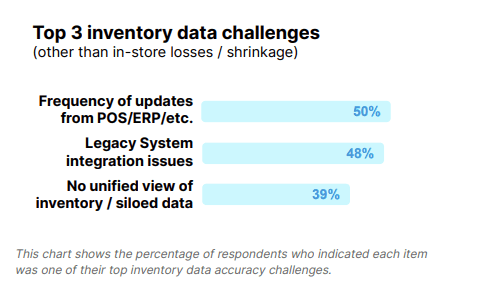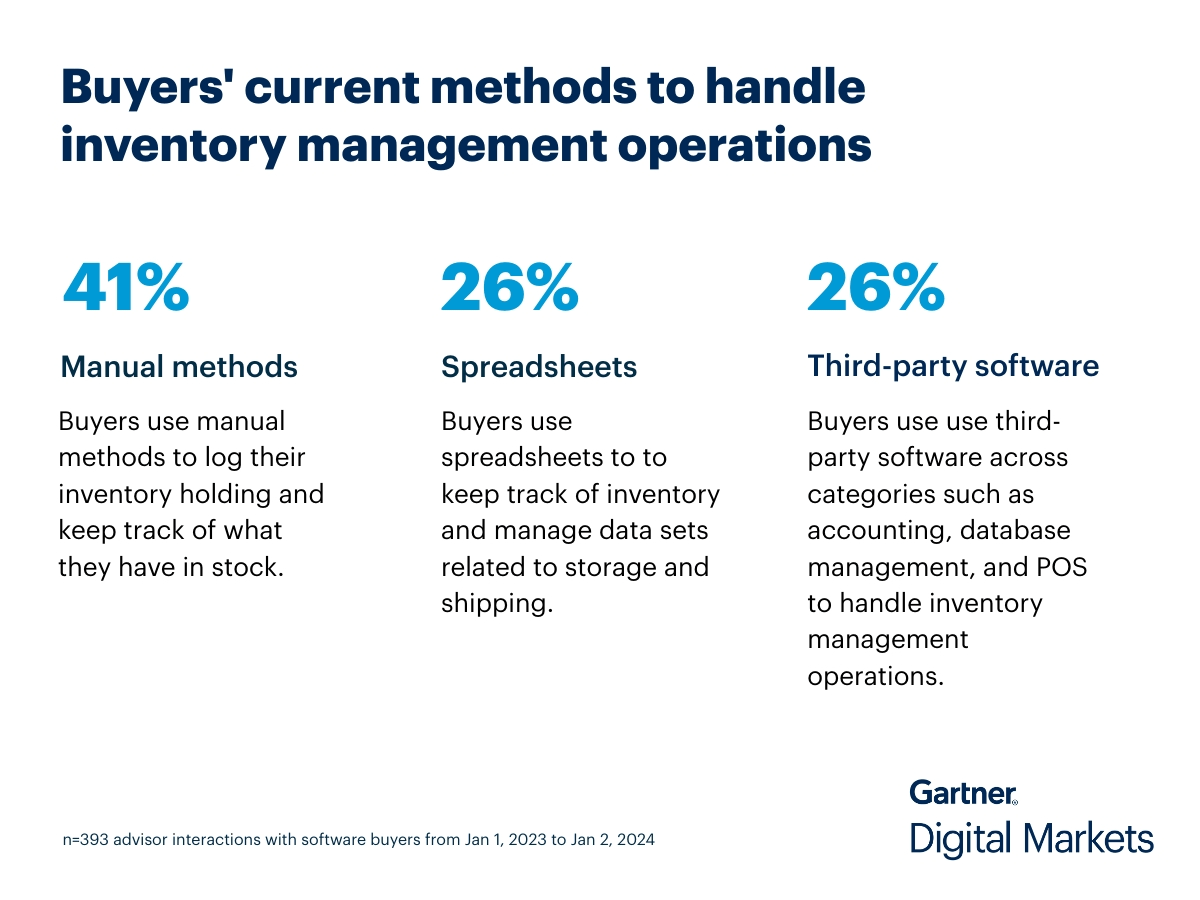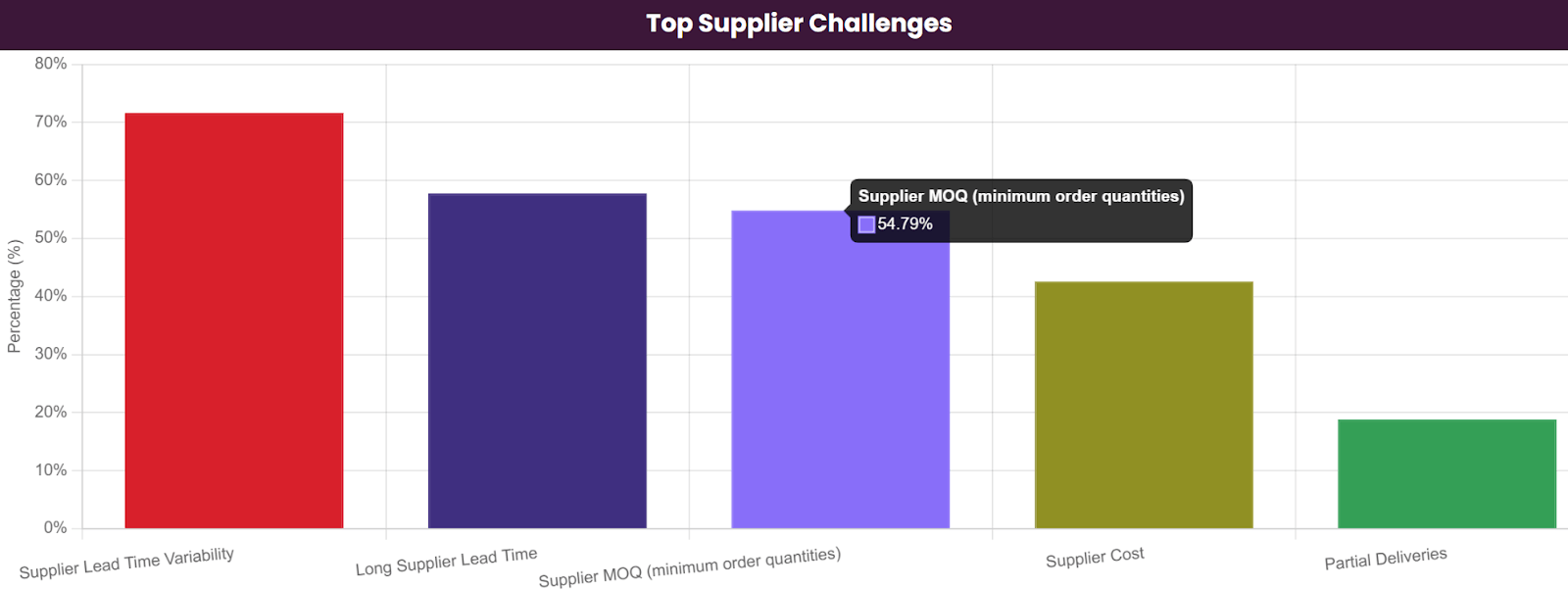9 Common Inventory Management Mistakes and How to Avoid Them
Waveon

Imagine your production line coming to a standstill because a vital raw material is out of stock. Or worse, your entire warehouse is choking on unsold products, tying up your capital and amassing storage costs. Such scenarios are a common occurrence in retail and ecommerce businesses.
Inventory distortion worldwide is a common yet costly issue for retailers. An IHL Group report found that the cost of overstock and out-of-stock products stood at $1.77 trillion in 2023, out of which out-of-stock scenarios cost $1.2 trillion.
Inaccurate data, missing parts, or excess stock can cause production delays and raise holding costs. On the flip side, effective inventory management keeps your stock levels in check, boosts cash flow, and improves operational efficiency.
In this article, we will discuss the common inventory management mistakes that hurt your business and practical ways to avoid them.
1. Poor Demand Forecasting
Relying on guesswork or intuition instead of data to forecast demand leads to overstocking, stockouts, and missed sales opportunities. These inventory challenges tie up your capital, lower customer satisfaction, and reduce your profitability.
Solution: Implement AI-powered inventory forecasting tools to predict demand precisely.
Notably, demand planning and forecasting in your supply chain boosts forecast reliability by 10-20%, lowers inventory cost by 20%, and improves supply chain efficiency by 15%.
With such accuracy, you ensure optimal inventory levels, meet customer demand without overstocking, and improve your overall company financials.
2. Lack of Real-Time Inventory Tracking
Not tracking inventory in real time can cause variations, leading to overselling, backorders, and challenges with order fulfillment. This clouded visibility can significantly affect your business financials and customer satisfaction.
Solution: Invest in a cloud-based inventory management software solution to track inventory in real time and sync data across sales channels. Here are the benefits:
Updated data on stock levels, inventory movement, and order statuses, anywhere and on any device
Increased operational efficiency with minimal manual interventions
Improved inventory accuracy. Particularly, 58% of retail brands and D2C manufacturers have below 80% inventory accuracy due to frequent ERP software updates, legacy integration problems, and decentralized data management.

So, a cloud-based inventory management system like Waveon can help you eliminate these inaccuracies and improve efficiency.
3. Inefficient Stock Replenishment
Relying on gut feeling to replenish inventory can cause inefficiencies, like stockouts and overstocking. When you understock, you lose out on sales opportunities. When you overstock, you tie up your capital in excess inventory, which you would otherwise invest in more lucrative ventures.
Inventory carrying costs also range between 20-30% of its total value. So, imagine how much money you would save by holding the right amount of stocks and replenishing optimally.
Solution: Implement an ERP system to automate stock replenishment with correct reordering points.
You can use historical sales data to optimize your minimum stock levels. This ensures fast-moving stock is consistently replenished to meet customer expectations, improving satisfaction and loyalty.
4. Overlooking Dead Stock and Obsolete Inventory
Retaining slow-moving or obsolete inventory (also known as dead stock) for an extended time results in wasted storage space and lost capital. Even for well-run companies, dead stocks can reduce cash flow and profitability.
Solution: Periodically analyze inventory reports and implement a First-In-First-Out (FIFO) approach to preserve fresh stocks and reduce spoilage. You can also offer discounts or promotions on older products before they expire to prevent tying up your cash flow for long.
5. Manual Inventory Management
41% of businesses still depend on manual methods to log their inventory holdings nd keep track of their stock levels.
Manual inventory tracking methods expose your business to the risk of human errors, low stock visibility, and delayed updates. Such inefficiencies can cause stock variations, production delays, and a rise in operational costs. You may also lose 11% of your annual revenue due to poor inventory management.
Solution: Shift to an automated inventory management system with features like barcode scanning, automated tracking, and instant reporting. It will substantially improve your operational efficiency while freeing up your time and reducing labor costs.
6. Poor Warehouse Organization
A disorderly warehouse layout can hinder order fulfillment efficiency, resulting in longer packing time and misplaced inventory. This results in higher labor costs and delayed order processing, which negatively affect customer experience.
Solution: Implement the right stock control strategies to use your warehouse space wisely.
For example, use ABC analysis to divide items into three groups based on their significance:
Category A: Takes up 20% of inventory and has the highest turnover
Category B: Accounts for 30% of the inventory and has moderate sales frequency
Category C: Have 50 units stored, but least requested by customers
Keep in mind there is no standard product categorization into the three groups. You can base it on your company's operations, product demand, and product attributes.
Bin locations to assign particular storage locations for every inventory item. It reduces the search and picking time and minimizes errors.
7. Ignoring Supplier Performance and Lead Times
Failing to track supplier performance and lead times can cause unanticipated delays and stock shortages. The aftermath is production interruptions, which prevent you from meeting customer demand.
Inaccurate or unpredictable deliveries (72%) are a bigger challenge than long lead times(58%) for most SMBs. This highlights the need for reliable suppliers.
Solution: Regularly examine supplier performance using KPIs, like material quality, timely delivery rates, and responsiveness. Also, diversify your supplier sources to reduce dependency on one supplier (especially at the start of your collaboration with a new supplier).
Hold a safety stock to cushion unexpected supplier delays, ensuring production or sales go on even with disruptions.
8. Lack of Inventory Audits and Reconciliation
Disregarding regular audits can cause variances between recorded and actual inventory levels, leading to inaccurate reporting. This can interrupt production schedules and erode stakeholder trust.
Solution: Set and adhere to a consistent inventory audit schedule to swiftly detect and handle discrepancies. Use automated tools to identify inaccuracies in both stock count and financial records.
9. Failure to Integrate Inventory with Sales and Accounting Systems
Neglecting inventory management integration with sales and accounting systems creates a dead spot and causes financial reporting issues. These inaccuracies can lower your profit margins.
Solution: Implement an integrated inventory management system to sync sales, procurement, and financial data. It ensures your inventory movements are automatically reflected in your financial records.
You can examine these comprehensive reports for better forecasting insights and optimal inventory planning.
Optimizing Inventory Management for Long-Term Success
Businesses that overlook these common inventory management mistakes are prone to the risk of production slowdowns, increase in storage costs, and lost revenue.
However, adopting modern inventory management solutions, like Waveon automates your entire inventory management process with real-time stock tracking and data updates. You can automate stock reordering and give your sales team an overview of your inventory.
Ready to take control of your inventory? Try Waveon for free!














